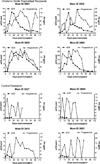Functions of ectopically transplanted invasive horse trophoblast
- PMID: 21389079
- PMCID: PMC5181105
- DOI: 10.1530/REP-10-0462
Functions of ectopically transplanted invasive horse trophoblast
Abstract
The invasive and fully antigenic trophoblast of the chorionic girdle portion of the equine fetal membranes has the capacity to survive and differentiate after transplantation to ectopic sites. The objectives of this study were to determine i) the survival time of ectopically transplanted allogeneic trophoblast cells in non-pregnant recipient mares, ii) whether equine chorionic gonadotropin (eCG) can be delivered systemically by transplanted chorionic girdle cells, and iii) whether eCG delivered by the transplanted cells is biologically active and can suppress behavioral signs associated with estrus. Ectopically transplanted chorionic girdle survived for up to 105 days with a mean lifespan of 75 days (95% confidence interval 55-94) and secreted sufficient eCG for the hormone to be measurable in the recipients' circulation. Immunohistochemical labeling of serial biopsies of the transplant sites and measurement of eCG profiles demonstrated that graft survival was similar to the lifespan of equine endometrial cups in normal horse pregnancy. The eCG secreted by the transplanted cells induced corpora lutea formation and sustained systemic progesterone levels in the recipient mares, effects that are also observed during pregnancy. This in turn caused suppression of estrus behavior in the recipients for up to 3 months. Thus, ectopically transplanted equine trophoblast provides an unusual example of sustained viability and function of an immunogenic transplant in a recipient with an intact immune system. This model highlights the importance of innate immunoregulatory capabilities of invasive trophoblast cells and describes a new method to deliver sustained circulating concentrations of eCG in non-pregnant mares.
Conflict of interest statement
Declarations of interest There is no conflict of interest that could be perceived as prejudicing the impartiality of the research reported.
Figures






Similar articles
-
Modeling trophoblast differentiation using equine chorionic girdle vesicles.Placenta. 2008 Feb;29(2):158-69. doi: 10.1016/j.placenta.2007.10.005. Epub 2007 Dec 3. Placenta. 2008. PMID: 18054076
-
Ectopic transplantation of equine invasive trophoblast.Biol Reprod. 2001 Mar;64(3):753-63. doi: 10.1095/biolreprod64.3.753. Biol Reprod. 2001. PMID: 11207188
-
Production of Mare Chorionic Girdle Organoids That Secrete Equine Chorionic Gonadotropin.Int J Mol Sci. 2023 May 31;24(11):9538. doi: 10.3390/ijms24119538. Int J Mol Sci. 2023. PMID: 37298490 Free PMC article.
-
Maternal immune responses to trophoblast: the contribution of the horse to pregnancy immunology.Am J Reprod Immunol. 2010 Oct;64(4):231-44. doi: 10.1111/j.1600-0897.2010.00895.x. Epub 2010 Jul 3. Am J Reprod Immunol. 2010. PMID: 20618178 Review.
-
Maternal immunological recognition of pregnancy in equids.J Reprod Fertil Suppl. 1989;37:69-78. J Reprod Fertil Suppl. 1989. PMID: 2681748 Review.
Cited by
-
Placentation in Equids.Adv Anat Embryol Cell Biol. 2021;234:91-128. doi: 10.1007/978-3-030-77360-1_6. Adv Anat Embryol Cell Biol. 2021. PMID: 34694479
-
Ectopic Trophoblast Allografts in the Horse Resist Destruction by Secondary Immune Responses.Biol Reprod. 2016 Dec;95(6):135. doi: 10.1095/biolreprod.115.137851. Epub 2016 Oct 19. Biol Reprod. 2016. PMID: 27760752 Free PMC article.
-
The equine endometrial cup reaction: a fetomaternal signal of significance.Annu Rev Anim Biosci. 2013 Jan;1:419-42. doi: 10.1146/annurev-animal-031412-103703. Epub 2012 Dec 13. Annu Rev Anim Biosci. 2013. PMID: 25387026 Free PMC article. Review.
-
Dynamic changes in gene expression and signalling during trophoblast development in the horse.Reproduction. 2018 Oct 1;156(4):313-330. doi: 10.1530/REP-18-0270. Reproduction. 2018. PMID: 30306765 Free PMC article.
References
-
- Adams AP, Antczak DF. Ectopic transplantation of equine invasive trophoblast. Biol Reprod. 2001;64:753–763. - PubMed
-
- Allen WR. The immunological measurement of pregnant mare serum gonadotrophin. J Endocrinol. 1969;43:593–598. - PubMed
-
- Allen WR, Moor RM. The origin of the equine endometrial cups. I. Production of PMSG by fetal trophoblast cells. J Reprod Fertil. 1972;29:313–316. - PubMed
-
- Allen WR, Short RV. Interspecific and extraspecific pregnancies in equids: anything goes. J Hered. 1997;88:384–392. - PubMed
Publication types
MeSH terms
Substances
Grants and funding
LinkOut - more resources
Full Text Sources
Other Literature Sources

